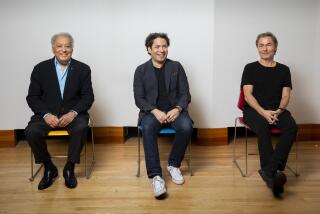Los Angeles Festival : ‘THE MAHABHARATA’: AN ‘ABORIGINAL’ MUSIC
- Share via
“The Mahabharata” is many things to many people. It makes an austere, sharply focused visual impression, and, yes, it is wordy.
But the play is also a sonic marvel, and not just in the sometimes folksy, sometimes courtly cadences of the spoken text. Five musicians play more than 40 instruments, from around the world.
This ecumenical approach to instrumentation gives the music a character more universal than specifically Indian. The sitar, in fact, is conspicuous only in its absence. “It would be too obvious,” explained musician Kim Menzer.
This internationalism is a deliberate part of director Peter Brook’s approach to the work. According to music director Toshi Tsuchitori, what Brook wanted was not Indian, European, or any specifically identifiable music, but rather a primitive, aboriginal music.
The music is based on four years of research into musics of Africa, Asia and the Middle East by Tsuchitori, layered with the ideas and experiences of the other musicians. “Each musician took the music in a different direction,” exclaimed Mahmoud Tabrizi-Zadeh.
The musicians worked closely with the actors in rehearsals, trying out different ideas, and gradually arriving at a consensual, very open music. “Some music is fixed, some is completely improvised,” stated Tsuchitori.
Sometimes the music is closely tied to events in the drama, whether in percussion patter underscoring movement, or the more subtle use of the flute--characteristic of Krishna--with the first appearance of that deity. It also functions more allusively, describing psychological and spiritual states, such as the large gong and throaty thrumming of the Australian didjeridu echoing Bhishma’s portentous vow.
The musicians were selected by Tsuchitori and Brook after an extensive search. They were chosen more for openness and improvisational skills than for their clear virtuosity on their own area of specialization, though all have studied Indian music closely.
Noted Indian violinist Subramaniam served as adviser to the project, and Tsuchitori has used three songs by Rabindranath Tagore, but the results are largely the achievement of these five players:
Tsuchitori--the Japanese director of the ensemble, playing a fantastic range of percussion instruments, as well as the koto, the large Japanese dulcimer;
Kudsi Erguner--a Turk who plays principally the ney , a Middle-Eastern wooden flute;
Djamchid Chemirani--an Iranian percussionist now living in France, where he has taught at the Sorbonne;
Menzer--a Dane with a jazz background, responsible for many different instruments, ranging from the nadaswaram , a south Indian oboe, to the large tamboura , a drone lute;
Tabrizi-Zadeh--an Iranian who plays the kamantche and santur , respectively a Middle-Eastern violin and dulcimer, as well as the dramatic role of Sahadeva.
Brook also wanted much color. Since melodic instruments carry more specific ethnic connotations, Tsuchitori has filled the ensemble with percussion large and small, to which all the players at some time turn their hands.
More to Read
The biggest entertainment stories
Get our big stories about Hollywood, film, television, music, arts, culture and more right in your inbox as soon as they publish.
You may occasionally receive promotional content from the Los Angeles Times.










